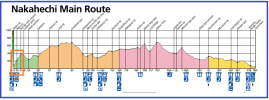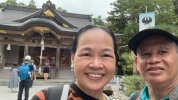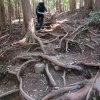- Time of past OR future Camino
- Oct 4 to Nov 5 2023 Camino Frances
Day 0 – Hong Kong to Osaka to Kii-Tanabe
Sept 29 – 30, 2024
It was almost exactly one year ago today when we started our pilgrimage to the Camino de Santiago last year.
This time we’re doing the Kumano Kodo, the sister pilgrimage of the Camino de Santiago in Japan.
But first, we must get to the starting point, a city called Kii-Tanabe in Wakayama, about 3 hours by rapid train south of Osaka.
Our flight was at 0705 HKT to 1155 OST (Japan is one hour ahead of Hong Kong). This means we must be at the airport very early (0500). Since getting to the airport at those hours was stressful (buses were few and far between, and a taxi would be too pricy) we decided to spend the night at the airport.
This is the first time we ever did this in our years of traveling, and it wasn’t as bad as we expected. At the airport, we still managed to get some food, although the restaurants were already closing because it was almost midnight. Only McDonald’s offers 24-hour service.
It turns out, many people spend the night at the airport to catch their early morning flights. We saw people with sleeping bags, mats, etc., really prepared to spend the night. We found a spot in the arrival hall where the seats are wide comfortable enough to lie down if you wanted to. It took a while, but Tess (my wife) and I managed to get some sleep. I sort of catnapped for 30-minute stretches.
We got up about 3 hours before our flight and proceeded to the counter only to find a long queue of passengers already there even though the counters were still closed. Anyway, check-in was efficient and quick considering the huge crowd of passengers. We still had time to grab breakfast at McDonald’s before proceeding to our gate.
The flight departed as scheduled and was uneventful. We took HK Express which is relatively comfortable and efficient for a budget airline. My only complaint is that the aircraft had only three toilets for about 200 passengers on a four-and-a-half-hour flight. Almost everyone spent to whole flight sleeping despite some stretches of turbulence.
Arriving at Kansai International Airport was uneventful although many things have changed in terms of airport procedures since the last time we were here in Feb 2018 before covid.
Foreigners (non-Japanese) must fill in an arrival card (you can do this during the flight), go through immigration, claim their luggage, fill in a declaration form even if you have nothing to declare, and get a QR Code from one of the airport terminals. This took time because of the huge volume of arriving passengers.
We had to catch the 13:32 rapid train to Kii-Tanabe and I was worried we wouldn’t make it on time. Fortunately, we found the Tourist Information Centre quickly after exiting the arrival hall and here a very efficient young man who spoke perfect English assisted us in getting the tickets.
Just a tip: it’s better to know the schedule of the train you want to take beforehand to save time and stick to your travel schedule.
We found the train terminal and our platform quickly and boarded just five minutes before departure. Whew! That was close.
From KIX, we had to transfer to another station (Hineno) to take the 13:57 train that would take us to Kii-Tanabe. Finding the station was easy (it was only 2 stops after KIX). We got to Hineno about 10 minutes before departure.
But we had some anxious moments at Hineno finding the right platform for Kii-Tanabe. Fortunately, we had some help from a local girl (a commuter) who spoke good English (she said she wasn’t Japanese).
The train ride to Kii-Tanabe was uneventful. Since we didn’t have time to get lunch at the airport, we had some of the light snacks we brought with us for such an occasion.
After 2 hours, we disembarked at Kii-Tanabe and went straight to the Tourist Office which was just next door to the train station. The staff was very helpful. They gave us maps, our credentials, the bus schedules, and directions.
We then went to the 7-11 next door (here they have an ATM that takes foreign cards), bought some food to go, and walked to our hotel which was just 5 minutes away. We arrived at about 1600 and fell asleep quickly since we were tired.
It’s 22:40 local time as I typed this. After a few hours’ sleep, I’m feeling recovered and ready to start tomorrow’s walk on the Kumano Kodo.
My takeaway for today is: Getting to the starting point isn’t always easy but it’s worth it.
Thanks for reading this far, going back to sleep.
Bani
Sept 29 – 30, 2024
It was almost exactly one year ago today when we started our pilgrimage to the Camino de Santiago last year.
This time we’re doing the Kumano Kodo, the sister pilgrimage of the Camino de Santiago in Japan.
But first, we must get to the starting point, a city called Kii-Tanabe in Wakayama, about 3 hours by rapid train south of Osaka.
Our flight was at 0705 HKT to 1155 OST (Japan is one hour ahead of Hong Kong). This means we must be at the airport very early (0500). Since getting to the airport at those hours was stressful (buses were few and far between, and a taxi would be too pricy) we decided to spend the night at the airport.
This is the first time we ever did this in our years of traveling, and it wasn’t as bad as we expected. At the airport, we still managed to get some food, although the restaurants were already closing because it was almost midnight. Only McDonald’s offers 24-hour service.
It turns out, many people spend the night at the airport to catch their early morning flights. We saw people with sleeping bags, mats, etc., really prepared to spend the night. We found a spot in the arrival hall where the seats are wide comfortable enough to lie down if you wanted to. It took a while, but Tess (my wife) and I managed to get some sleep. I sort of catnapped for 30-minute stretches.
We got up about 3 hours before our flight and proceeded to the counter only to find a long queue of passengers already there even though the counters were still closed. Anyway, check-in was efficient and quick considering the huge crowd of passengers. We still had time to grab breakfast at McDonald’s before proceeding to our gate.
The flight departed as scheduled and was uneventful. We took HK Express which is relatively comfortable and efficient for a budget airline. My only complaint is that the aircraft had only three toilets for about 200 passengers on a four-and-a-half-hour flight. Almost everyone spent to whole flight sleeping despite some stretches of turbulence.
Arriving at Kansai International Airport was uneventful although many things have changed in terms of airport procedures since the last time we were here in Feb 2018 before covid.
Foreigners (non-Japanese) must fill in an arrival card (you can do this during the flight), go through immigration, claim their luggage, fill in a declaration form even if you have nothing to declare, and get a QR Code from one of the airport terminals. This took time because of the huge volume of arriving passengers.
We had to catch the 13:32 rapid train to Kii-Tanabe and I was worried we wouldn’t make it on time. Fortunately, we found the Tourist Information Centre quickly after exiting the arrival hall and here a very efficient young man who spoke perfect English assisted us in getting the tickets.
Just a tip: it’s better to know the schedule of the train you want to take beforehand to save time and stick to your travel schedule.
We found the train terminal and our platform quickly and boarded just five minutes before departure. Whew! That was close.
From KIX, we had to transfer to another station (Hineno) to take the 13:57 train that would take us to Kii-Tanabe. Finding the station was easy (it was only 2 stops after KIX). We got to Hineno about 10 minutes before departure.
But we had some anxious moments at Hineno finding the right platform for Kii-Tanabe. Fortunately, we had some help from a local girl (a commuter) who spoke good English (she said she wasn’t Japanese).
The train ride to Kii-Tanabe was uneventful. Since we didn’t have time to get lunch at the airport, we had some of the light snacks we brought with us for such an occasion.
After 2 hours, we disembarked at Kii-Tanabe and went straight to the Tourist Office which was just next door to the train station. The staff was very helpful. They gave us maps, our credentials, the bus schedules, and directions.
We then went to the 7-11 next door (here they have an ATM that takes foreign cards), bought some food to go, and walked to our hotel which was just 5 minutes away. We arrived at about 1600 and fell asleep quickly since we were tired.
It’s 22:40 local time as I typed this. After a few hours’ sleep, I’m feeling recovered and ready to start tomorrow’s walk on the Kumano Kodo.
My takeaway for today is: Getting to the starting point isn’t always easy but it’s worth it.
Thanks for reading this far, going back to sleep.
Bani
Last edited:
























